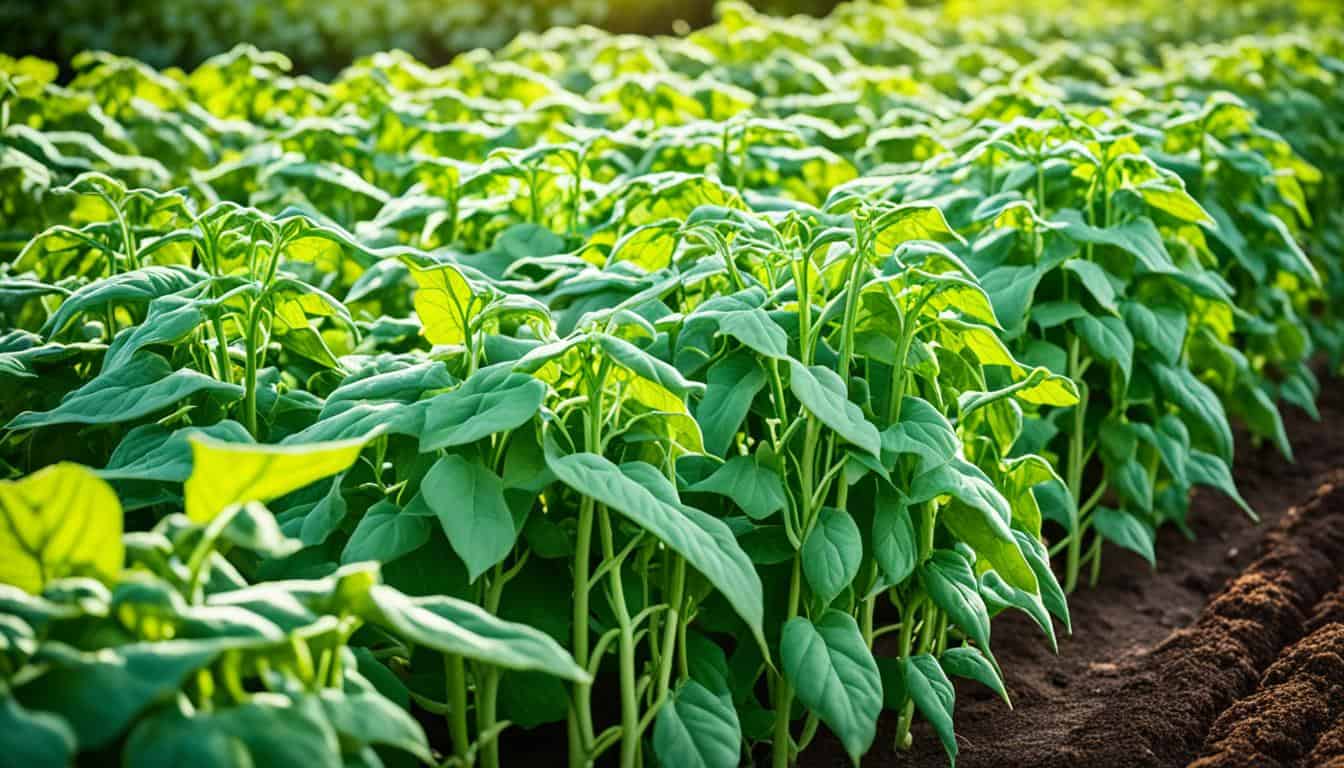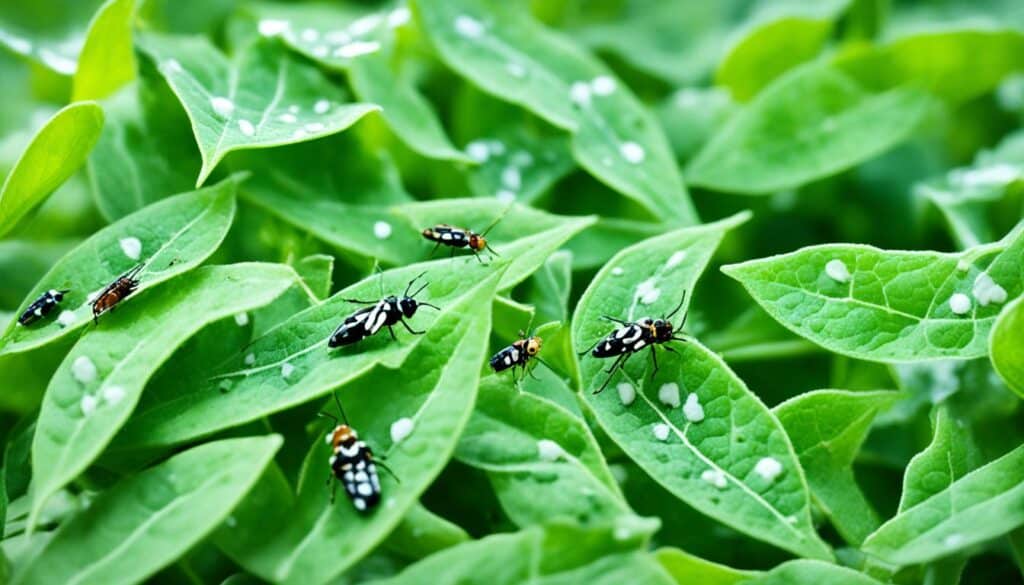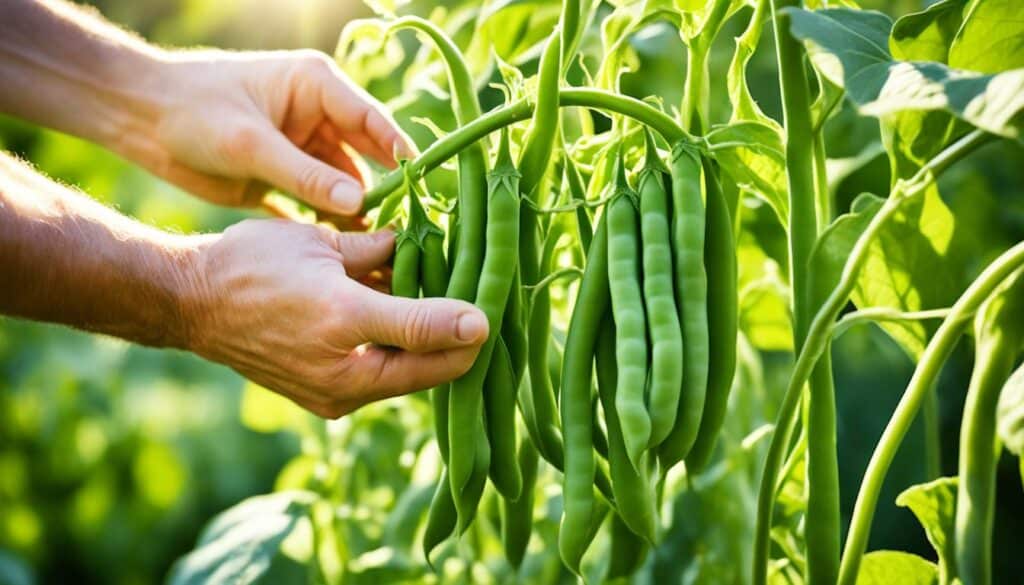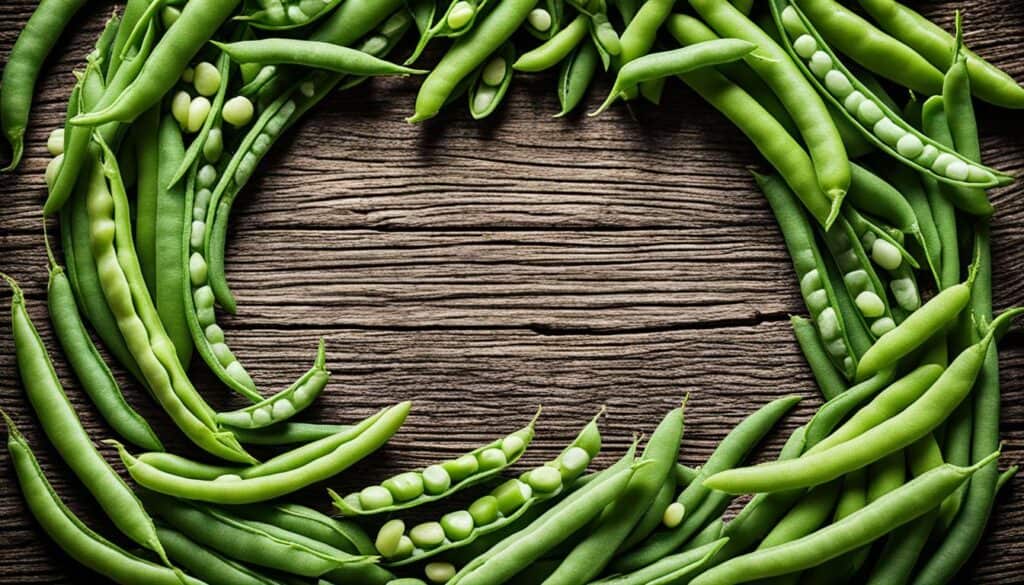Did you know that green beans, also known as string beans or snap beans, are one of the most widely cultivated and consumed vegetables in the world? In fact, global production of green beans exceeded 23 million metric tons in 2020 alone! Whether you’re a seasoned gardener or just starting out, growing your own green beans can be a rewarding experience.
In this comprehensive guide, I will walk you through the process of planting and growing high-quality green bean seeds in your home garden. From selecting the best organic and heirloom seeds to harvesting the freshest pods, you’ll learn everything you need to know to cultivate your own delicious green beans.
Key Takeaways:
- Green beans are a widely cultivated and consumed vegetable, with global production exceeding 23 million metric tons in 2020.
- This comprehensive guide will provide you with all the information you need to successfully plant and grow high-quality green bean seeds in your home garden.
- By following the steps outlined in this guide, you’ll be on your way to enjoying a bountiful harvest of fresh and organic green beans.
- Choose from a variety of green bean seed options, including organic, heirloom, and non-GMO seeds, for the best results.
- Get ready to experience the satisfaction of growing your own delicious and nutritious green beans right at home!
Why Grow Green Beans?
If you’re considering what to grow in your garden, green beans should be at the top of your list. There are numerous benefits to growing green beans, making them a fantastic addition to any home garden. From their ease of cultivation to their nutritional value, let’s explore the advantages of green bean cultivation.
1. Easy and Suitable for Novice Gardeners
One of the main reasons to grow green beans is their simplicity. Whether you’re just starting your gardening journey or have limited experience, green beans are an excellent choice. They are easy to grow and require minimal maintenance, making them a great option for novice gardeners.
2. Abundant Harvest
When you grow green beans, you’ll be rewarded with a generous harvest. These plants are productive and can yield a bountiful supply of fresh beans. From a small garden plot to a larger backyard, green beans can provide you with a plentiful harvest throughout the growing season.
3. Nutritious and Delicious
Green beans are not only tasty but also packed with nutrients. They are rich in vitamins and minerals, including vitamin C, vitamin K, manganese, and potassium. Additionally, green beans are high in fiber and low in calories, making them a healthy addition to your meals.
4. Quality Control
By growing your own green beans, you have control over the quality of the seeds and the cultivation process. You can ensure that the seeds you use are non-GMO, organic, and free from pesticides and chemicals. This gives you the peace of mind of knowing exactly what you’re consuming and feeding your family.
“Green beans are a versatile and rewarding vegetable to grow in your home garden.”
When you consider the benefits of growing green beans, it’s easy to see why they are a popular choice among gardeners. From their ease of cultivation and abundant harvests to their nutritional value and quality control, green beans offer a range of advantages. Whether you’re a novice gardener or an experienced enthusiast, growing green beans can be a satisfying and fulfilling experience.
Types of Green Beans
Green beans come in a wide variety of types, each with its own unique characteristics. Whether you prefer the classic taste of a bush bean or the climbing nature of a pole bean, there is a green bean variety that will suit your gardening preferences. Here are some popular green bean cultivars:
Antigua Bush Bean
The Antigua bush bean is a well-loved variety known for its tender pods and excellent flavor. It produces abundant yields and is easy to grow, making it a favorite among home gardeners.
Blue Lake Pole Bean
The Blue Lake pole bean is a classic heirloom variety that is known for its straight, stringless pods and rich, earthy flavor. It is a vigorous climber and requires sturdy support for optimal growth.
Borsalino French Bean
The Borsalino French bean is a delightful variety with slender, dark green pods that are tender and sweet. It is highly productive and resistant to common bean diseases, making it a reliable choice for gardeners.
Carminat Pole Bean
The Carminat pole bean is a beautiful variety that produces long, deep-red pods. These juicy pods have a delectable flavor and retain their color even after cooking. They are a great addition to salads and stir-fries.
Celine Bush Bean
The Celine bush bean is a compact and early-maturing variety that is perfect for small gardens. It produces uniform, straight pods that have a mild and tender taste. Its disease resistance and high yields make it a popular choice among gardeners.
Dragon Tongue Bush Bean
The Dragon Tongue bush bean is a visually striking variety with pale yellow pods mottled with purple streaks. It has a rich and creamy flavor and can be enjoyed both fresh and cooked. This unique bean variety adds a pop of color to any dish.
| Green Bean Variety | Characteristics |
|---|---|
| Antigua Bush Bean | Tender pods, excellent flavor |
| Blue Lake Pole Bean | Straight, stringless pods, rich flavor |
| Borsalino French Bean | Slender, dark green pods, resistant to diseases |
| Carminat Pole Bean | Long, deep-red pods, juicy and flavorful |
| Celine Bush Bean | Compact and early-maturing, mild and tender taste |
| Dragon Tongue Bush Bean | Pale yellow pods with purple streaks, rich and creamy flavor |
When selecting green bean seeds, be sure to carefully read the seed packets to determine whether the variety is a bush bean or a pole bean, as their growing habits differ. With these different types and varieties of green beans, you can add a myriad of colors, flavors, and textures to your vegetable garden and culinary creations.
When and Where to Plant Green Beans
Green beans thrive in warm weather and should be planted after the danger of frost has passed. The ideal planting time is in late spring when the soil has warmed up.
Green beans require full sun, with a minimum of six hours of direct sunlight daily. The soil should be fertile, well-worked, and have a pH between 6.0 and 7.0.
You can sow the seeds directly into the garden or start them indoors and transplant them outdoors once the soil reaches 70°F. It’s important to provide support, such as a trellis or teepee, for pole beans to climb.
- Plant green beans after the danger of frost has passed in late spring.
- Choose a location with full sun exposure.
- Prepare fertile and well-worked soil with a pH between 6.0 and 7.0.
- Sow seeds directly into the garden or start indoors and transplant outdoors.
- Provide support for pole beans to climb.
Creating optimal conditions for growing green beans will ensure a successful harvest of these delicious and nutritious vegetables.
How to Plant Green Beans
To successfully cultivate green beans, it’s important to know the proper planting techniques. Follow these steps to ensure a successful growing season:
-
Choose the Right Location: Select a sunny spot in your garden with well-drained soil. Green beans thrive in full sunlight, so make sure to choose a location that receives at least 6 hours of direct sunlight each day.
-
Prepare the Soil: Before planting, prepare the soil by removing any weeds and adding organic matter like compost or well-rotted manure. This will provide the beans with essential nutrients for healthy growth.
-
Sowing Green Bean Seeds: Sow the green bean seeds directly into the garden. Dig a small hole about 1 inch deep and place a seed in each hole, following the spacing recommendations on the seed packet.
-
Spacing: For bush beans, space the seeds or seedlings about every 4-6 inches in rows that are 12 inches apart. If you’re growing pole beans, plant 3 seeds or seedlings around each pole.
-
Watering: After planting, water the seeds thoroughly to ensure good germination. It’s important to keep the soil consistently moist throughout the growing season.
-
Mulching: Cover the ground around the green bean plants with a layer of organic mulch. This helps retain moisture, suppress weeds, and maintain a more stable soil temperature.
Here’s a helpful table that summarizes the planting process for both bush beans and pole beans:
| Bush Beans | Pole Beans |
|---|---|
| Space seedlings or seeds every 4-6 inches | Plant 3 seeds or seedlings around each pole |
| Space rows 12 inches apart | – |
| Sow seeds directly into the garden | – |
Remember to provide support for pole beans by setting up trellises, stakes, or teepees for the vines to climb on. This not only helps the plants grow vertically but also makes harvesting easier.
Transplanting Green Bean Seedlings
If you choose to start your green beans indoors, start the seeds in a sterile seed-starting mix at least 2-3 weeks before the last expected frost. Keep the seedlings under grow lights to ensure adequate light exposure.
When the soil outdoors reaches a temperature of at least 70°F and all danger of frost has passed, you can transplant the seedlings into your garden. Before planting them out, harden off the seedlings by gradually exposing them to the outdoor conditions over the course of a week. This will help them adjust to the temperature, light, and wind variations.
By following these planting guidelines, you’ll be on your way to growing healthy green bean plants and enjoying a bountiful harvest.
Caring for Green Bean Plants
Once your green bean plants are in the ground, it’s important to provide them with proper care to ensure a healthy and abundant harvest. Here are some essential tips for caring for your green bean plants:
Watering Green Beans
Consistent moisture is crucial for the growth and development of green beans. Water your plants regularly, especially during dry periods, to keep the soil moist. However, it’s important to avoid overhead watering, as wet foliage can invite diseases. Instead, water the plants at the base to directly reach the roots.
Fertilizing Green Beans
Green beans are nitrogen-fixing legumes, which means they have the ability to convert atmospheric nitrogen into a usable form for themselves and other plants. As a result, they don’t require excessive amounts of additional fertilizer. However, amending the soil with compost before planting can provide beneficial nutrients and promote healthy growth.
Preventing Pests and Diseases in Green Bean Plants
Monitor your green bean plants for common pests such as Mexican bean beetles, aphids, and thrips. Early detection is key to preventing infestations, so regularly inspect the leaves and stems for any signs of damage. If you spot any pests, you can control them organically by using insecticidal soap or neem oil. Additionally, practicing crop rotation and maintaining good garden hygiene can help reduce the risk of diseases.
Mulching around the base of your green bean plants with straw or shredded leaves can help retain soil moisture, suppress weed growth, and create a favorable environment for healthy roots. Remember to keep an eye out for any signs of stress or nutrient deficiencies and address them promptly to ensure your green bean plants thrive.
Caring for your green bean plants involves providing consistent moisture, amending the soil with compost, and preventing and controlling pests and diseases. Following these tips will help you cultivate healthy green bean plants and enjoy a bountiful harvest of delicious beans.
Harvesting Green Beans
When it comes to harvesting green beans, timing is everything. You want to pick the pods at just the right moment to ensure they are tender and full of flavor. But how do you know when the time is right? Here’s everything you need to know about harvesting green beans.
Green beans are ready to be harvested when the pods have reached the ideal size and are still tender. This is usually when they are around 4 to 6 inches long, depending on the variety. You can check the maturity of the pods by gently pressing them with your fingers. If they give a little and snap easily, they are ready to be picked.
To ensure a continuous harvest throughout the growing season, it’s important to pick the pods every few days as they reach the desired size. This not only allows you to enjoy a steady supply of fresh green beans but also encourages the plants to produce more flowers and pods.
When it’s time to harvest, hold the stem of the pod with one hand and gently twist it off the plant with the other. This twisting motion helps to detach the pod without damaging the plant. Avoid pulling or tugging on the pods, as this can lead to plant damage.
Tips for Harvesting Green Beans:
- Harvest green beans in the morning when the plants are well-hydrated.
- Use clean, sharp scissors or garden shears to remove any stubborn pods.
- Promptly remove any over-mature pods to prevent the plant from diverting energy into seed production instead of producing more pods.
- If you accidentally break a pod while harvesting, use it immediately rather than storing it, as it can quickly spoil.
By following these tips, you’ll be able to harvest a plentiful supply of fresh, delicious green beans from your garden. Enjoy them steamed, sautéed, grilled, or added to your favorite recipes for a burst of flavor and nutrition.
| Variety | Pod Length | Flavor Profile |
|---|---|---|
| Blue Lake | 5-6 inches | Classic, crisp, and slightly sweet |
| Romano | 8-9 inches | Meaty, buttery, and slightly nutty |
| Haricot Verts | 4-5 inches | Tender, delicate, and mild |
| Dragon Tongue | 4-6 inches | Adventurous, buttery, and slightly spicy |
Best Green Bean Varieties to Grow
When it comes to choosing the best green bean varieties to grow in your garden, there are several factors to consider. Flavor, yield, disease resistance, and growth habit all play a role in determining which varieties will thrive in your specific growing conditions. To help you make the right decision, I’ve compiled a list of top-rated green bean seeds that are highly recommended by home gardeners:
| Variety | Plant Type | Flavor | Yield | Disease Resistance |
|---|---|---|---|---|
| Mascotte bush bean | Bush | Mild and sweet | Abundant | High resistance |
| Provider bush bean | Bush | Classic green bean flavor | Consistent | High resistance |
| Contender bush bean | Bush | Tender and flavorful | Productive | High resistance |
| Emerite pole bean | Pole | Delicate and nutty | High | High resistance |
| Fortex pole bean | Pole | Rich and buttery | Exceptional | High resistance |
| Scarlet Runner bean | Pole | Distinctive and robust | Generous | High resistance |
These top-rated green bean varieties have consistently performed well in terms of flavor, yield, and disease resistance. Whether you prefer bush beans for their compact size or pole beans for their climbing ability, there is a variety on this list that will meet your needs. Experiment with different varieties to discover your favorites and enjoy a bountiful harvest of delicious green beans.
Tips and Tricks for Green Bean Success
To ensure a successful green bean harvest, here are some helpful tips and tricks:
- Plant green beans in succession every two to three weeks for a continuous harvest. This practice ensures that you have a steady supply of fresh green beans throughout the growing season. By staggering your plantings, you can enjoy a consistent yield and avoid an overwhelming surplus all at once.
- Provide proper support for pole beans to prevent them from sprawling on the ground. Pole beans are known for their vigorous climbing habit, and they require a sturdy support structure to grow vertically. Use trellises, stakes, or teepees to guide the vines upward, maximizing space and improving air circulation around the plants.
- Avoid planting green beans in the same spot each year to reduce the risk of disease and pest infestations. Rotating your green bean plantings helps prevent the buildup of soil-borne pathogens and pests that can harm your plants. Switching locations each year can improve plant health and productivity.
- Monitor the plants regularly for signs of pests and diseases and take immediate action if necessary. Common pests that may target green beans include aphids, Mexican bean beetles, and thrips. Regularly inspect the plants for any signs of damage, such as chewed leaves or wilting, and take appropriate measures to control the pests organically.
- Preserve excess green beans by pickling, blanching, or freezing them for future use. If you find yourself with more green beans than you can consume fresh, consider preserving them for later. Pickling, blanching, and freezing are effective methods for extending the shelf life of green beans, allowing you to enjoy their delicious flavor even after the growing season ends.
By following these tips and tricks, you can optimize your green bean production and enjoy a bountiful harvest of these tasty and nutritious vegetables!
Conclusion
After reviewing this comprehensive green bean planting guide, it is clear that green beans are a versatile and rewarding vegetable to grow in your home garden. By following the planting tips and caring for your green bean plants, you can expect a bountiful harvest of fresh, organic green beans.
Whether you choose the convenient bush beans or the climbing pole beans, there is a wide variety of options to suit your preferences. From the Antigua bush bean with its vibrant purple pods to the classic Blue Lake Pole bean known for its tender texture, you can experiment with different flavors and appearances.
With proper care and attention, your green bean plants will reward you with an abundance of tender, flavorful pods that can be used in a variety of delicious dishes. From stir-fries and salads to soups and casseroles, the possibilities are endless.
So, roll up your sleeves, get your hands dirty, and embark on the journey of growing your own green beans. With the knowledge you have gained from this guide, you are well-equipped to create a thriving garden and enjoy the satisfaction of harvesting your own homegrown green beans. Happy planting!









Leave a Reply